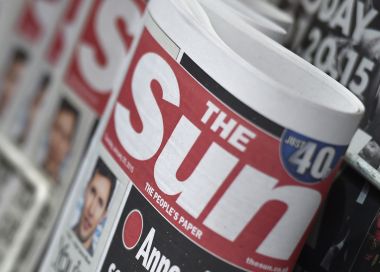Carey Lodge: Page 3 might have covered up but it's not a triumph for feminism yet

The news that The Sun newspaper has finally abandoned its farcical Page 3 has been met with much celebration – and rightly so.
Speculation broke out late last night that Rupert Murdoch's media empire was finally killing off of its archaic feature, an inconceivable 45 years after its inception. According to the Times, Friday's edition was the last to print a topless woman – though the Sun is yet to release an official statement on the matter. An evasive tweet from head of PR Dylan Sharpe yesterday simply said: "Page 3 will be in @TheSunNewspaper tomorrow in the same place it's always been – between page 2 and page 4."
Unlike the usual bare offering, Monday's Page 3 featured model Rosie Huntington-Whiteley at least slightly covered up in lingerie, while today's paraded a pair of soap actresses in bikinis. Despite the Sun's attempts to dodge questioning, it seems that topless models – a source of great contention for many – may indeed have been relegated to the history books.
It's an incredible victory for the No More Page 3 campaign. A spokeswoman said it could be "a huge step for challenging media sexism" and online activists have been quick to celebrate the feature's demise.
This step is seen as part of a wider movement to see fair representation of women in the media, and is welcomed as significant progress in the fight for equality. There's also power in knowing that even the Sun might respond to a well-executed and dedicated campaign.
But this is no time to sit down, pat ourselves on the back and reach for a cup of tea. There is still far more to be done.
While Page 3 may no longer appear in print, it remains online. The Page 3 Twitter account tweeted a revealing picture of "flame-haired beauty Lucy" this morning, with a link to its paywalled website. And let's be honest, the updated print version is no less objectifying than its predecessor. Sure, the women might be wearing a bra, but it doesn't exactly scream liberation to me.
As long as women are commodified in the media, we haven't done enough. The issue is not nudity, as such, or an issue with the display of womanhood, but rather the fact that the female body is consistently and relentlessly portrayed as something to be consumed.
The primary problem with Page 3 is that it embodies a deeply ingrained mistreatment of women. It is a concept dreamt up not by the models themselves, but by men and women who recklessly use these women's bodies for commercial gain. It's exploitative, manipulative and troubling to see in a country that claims to be committed to equal opportunity. How this practice has continued in a "family" newspaper for nearly half a century is staggering.
We need people to champion women for their achievements, not their cup-size. Yes, the female body should be celebrated in all shapes and sizes, but that's not what The Sun does, however sweetly their PR team might try to spin it. Women have a right to be portrayed as equally intelligent and capable as men, and sprawling double-page spreads of Nadia from Leeds in a tiny bikini does nothing for the cause. She's worth more than that.
So we still need campaigns like This Girl Can and Ask Her More. We still need men to champion feminism, and women to support one another in believing that our value is greater than that so graciously bestowed upon us by Murdoch. We have an inherent dignity to protect, and the fight is not over just yet.
Carey Lodge is a journalist for Christian Today.











